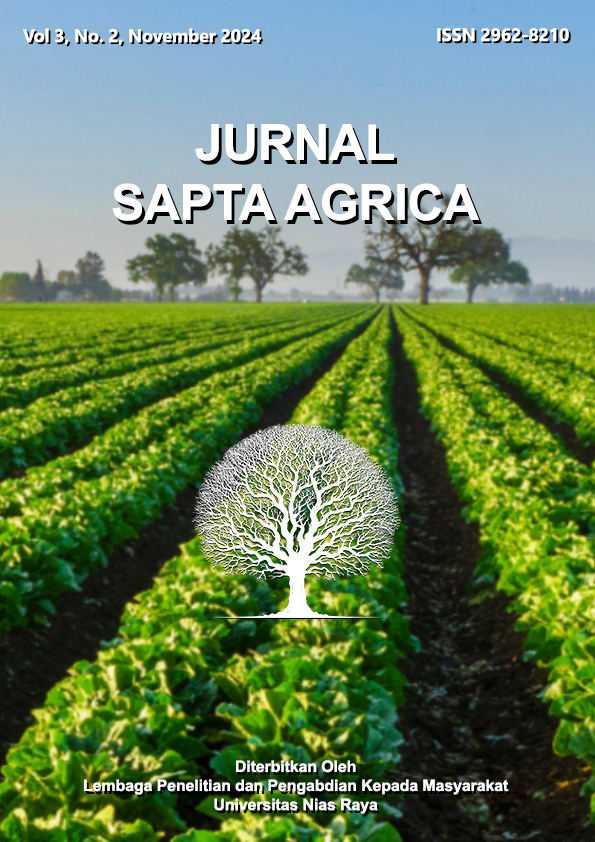EVALUASI TIGA MACAM AUKSIN SINTETIK TERHADAP PERTUMBUHAN AKAR LIDAH MERTUA
Sansevieria Laurentii
Abstract
The propagation of snake plants is efficient when using leaf organs. However, the problem is the growth of roots. Auxin is a plant growth regulator that can stimulate root growth. There are several synthetic auxins and must be applied to obtain the best results in snake plant root growth. The materials used in this experiment were snake plant leaves, synthetic auxin (AUKSIN, Rootone-F, and Atonik), soil, and containers. The tools used included a cutter, ruler, stationery, and camera. Synthetic auxin was applied by smearing it on one part of the leaf base. The experimental design was a Completely Randomized Design, with four treatments: control (without auxin), AUKSIN, Rootone-F, and Atonik. Each treatment had three replications, resulting in twelve experimental units. The data obtained were analyzed using ANOVA and followed by DMRT. The results showed that snake plants treated with Atonik produced the best results and differed from the control significantly.
References
Arifin, A. Z., Hidayanto, F., & Mahfud, R. I. (2022). The Effectiveness Of Substances In Growth Regulators On Growth Of Root Cutting Of Mother-In Law’s Tongue Leaves (Sansevieria trifasciata). Jurnal Agronomi Tanaman Tropika (JUATIKA), 4(1), 139–146. https://doi.org/10.36378/juatika.v4i1.1780
Ariska, N., Lizmah, S. F., & Fajri, F. (2020). Pengaruh Jenis dan Konsentrasi ZPT Alami terhadap Pertumbuhan Stek Lada (Piper nigrum L.). Jurnal Agrotek Lestari, 6(1), 16-27. https://doi.org/10.35308/jal.v6i1.2370
Azhar, F., Bahar, E., Rizwana Wahyuni, R., (2021). Pengaruh Beberapa Konsentrasi Zat Pengatur Tumbuh Auksin Sintetik terhadap Pertumbuhan Stek Jambu Air (Syzygium aqueum). Jurnal Sungkai, 9(2); 43-51. https://doi.org/10.30606/sungkai.v9i2.909
Jamal, A. (2016). Effect of IBA (Indole Butyric Acid) levels on the growth and rooting of different cutting types of Clerodendrum splendens. Pure Applied Biology, 5(1), 64–71. https://doi.org/10.19045/bspab.2016.50009
Mutryarny, E. (2020). Natural ZPT Effect On Growth And Production of Shallot (Allium ascalonicum L). SINTA Journal (Science, Technology, and Agricultural), 1(1), 19-27
Nengsih, Y., Hartawan, R., Purba, K., & Wahyu, A. D. (2023). Perbandingan Efektivitas Zat Pengatur Tumbuh Organik dan Anorganik dalam Mendukung Pertumbuhan Stek Kopi Robusta. Jurnal Media Pertanian, 8(2), 130. https://doi.org/10.33087/jagro.v8i2.206
Prameswari, W., Herman, W., Oktavia, D., Agustian Efendi, (2023). Pengaruh Bagian Stek dan Konsentrasi Indole Butyric Acid (IBA) terhadap Perakaran Dan Tingkat Keberlangsungan Hidup Pada Stek Cabe Jawa (Piper retrofractum Vahl.). Seminar Nasional Pertanian Pesisir, 2(1): 316-323.
Thamrin, N. T. (2021). Pengaruh Konsentrasi Zpt Auksin Terhadap Pertumbuhan Tanaman Anggrek. PLANTKLOPEDIA: Jurnal Sains dan Teknologi Pertanian, 1(2), 1-7.
Thahir, R., & Magfirah, N. (2021). Pengaruh Konsentrasi Ekstrak Bawang Merah terhadap Setek Daun Sansevieria trifasciata. In 38 Jurnal Binomial 4(1), 38-52. https://doi.org/10.46918/bn.v4i1.844
Wulantika, T., Pertanian, P., & Payakumbuh, N. (2020). Natural ZPT Effect on Growth and Production of Shallot (Allium ascalonicum L). Article in SINTA Journal (Science Technology and Agricultural. https://doi.org/10.37638/sinta.1.1.19
Wibowo, A. F., & Kristanto, A. B. (2023). Pengaruh Zat Pengatur Tumbuh (ZPT) Auksin Sintetik dan Auksin Alami terhadap Pertumbuhan Stek Tanaman Vanili (Vanilla planifolia Andrews). AGROHITA, 8(1):71-80. https://doi.org/10.31604/jap.v8i1.8119
Yani, F., & Warid, D. (2022). Respon Tanaman Lidah Mertua terhadap Beberapa Jenis Media Tanam dalam Performa Kokedama. Jurnal Bioindustri, 5(1): 25-34. https://doi.org/10.31326/jbio.v5i1.732











